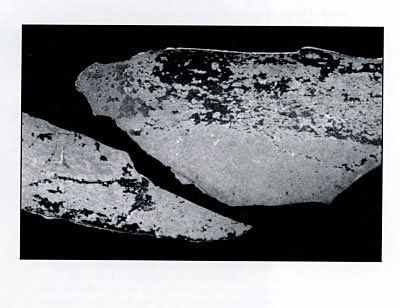 Paint
chip on metal base of a macro_camera stage
Paint
chip on metal base of a macro_camera stage  Paint chip a piece
of dark grey mount board
Paint chip a piece
of dark grey mount board Paint
chip on the home made shadow box
Paint
chip on the home made shadow boxMaking a smooth clean background
for small objects that are photographed using magnification
In the Fall of 1995, one of my students, Sheila Donnelly, was
doing an extended work study block at the Monroe County Crime Lab, located here
in Rochester under the supervision of criminologist Harvey Van Hoven. While
on there, she was asked to create a "better" "systematized"
approach to be used in the making of photomacro/micrographs of small opaque
evidence such as paint chips and fibers. The basic imaging problem revolved
around the camera systems ability to eliminate the texture from the surface
of the background materials that were being used at the time. Additionally,
there was considerable variability of the colors produced when using a white
card as a background color when photographing using color slide films. The transparencies
seemed to exhibit subtle color changes as a result of the film emulsion, the
background color/tone as well as the processing. Controlling these variation
would have great value for making better comparisons.
In analyzing a variety of possible solutions, one simple approach that was considered
incorporating methods found in several other techniques found in medical photography.
The most promising solution was to make an "semi" shadow box using
a clean and unused microscope slide. To do this, the bottom of a clean microscope
slide should be spray painted (only on the bottom with black or white). It was
speculated, that the very shallow depth of field traditionally found in this
magnification range would work to our advantage. This shallow depth of field
would allow all unwanted information from the texture of any background to be
eliminated and to be outside the depth of field produced from the taking lens.
This in turn would allow this sharpest focus to be placed effectively on the
sample surface with no competing information/texture. By painting the bottom
of the slide, the texture from the paint would out of focus and any shadows
created from the texture lighting would be absorbed in the black background
in the same way a shadow box works in gross specimen photography. Additionally,
the smooth surface of the glass would serve as a very clean surface which would
produce, few if any artifacts. We chose a matte paint and one that would be
durable. Obviously the bargain basement paints would have little if any value
for such work.
Our goal was to isolate the samples by minimizing any any texture data produced
either from the surface of the background, or shadows produced from the sample
being that would be cast onto the background.
As can be seen from the 3 pictures seen below, the technique works well. Cleaning
is easy with a static master brush, however the glass surface is prone to scratches
so make several as they will break or scratch when it is least desirable.
 Paint
chip on metal base of a macro_camera stage Paint
chip on metal base of a macro_camera stage |
 Paint chip a piece
of dark grey mount board Paint chip a piece
of dark grey mount board |
 Paint
chip on the home made shadow box Paint
chip on the home made shadow box |
Michael Peres, MS, RBP, FBPA
December 1996